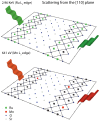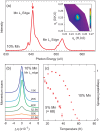Electronic superlattice revealed by resonant scattering from random impurities in Sr3Ru2O7
- PMID: 23903555
- PMCID: PMC3730170
- DOI: 10.1038/srep02299
Electronic superlattice revealed by resonant scattering from random impurities in Sr3Ru2O7
Abstract
Resonant elastic x-ray scattering (REXS) is an exquisite element-sensitive tool for the study of subtle charge, orbital, and spin superlattice orders driven by the valence electrons, which therefore escape detection in conventional x-ray diffraction (XRD). Although the power of REXS has been demonstrated by numerous studies of complex oxides performed in the soft x-ray regime, the cross section and photon wavelength of the material-specific elemental absorption edges ultimately set the limit to the smallest superlattice amplitude and periodicity one can probe. Here we show--with simulations and REXS on Mn-substituted Sr3Ru2O7--that these limitations can be overcome by performing resonant scattering experiments at the absorption edge of a suitably-chosen, dilute impurity. This establishes that--in analogy with impurity-based methods used in electron-spin-resonance, nuclear-magnetic resonance, and Mössbauer spectroscopy--randomly distributed impurities can serve as a non-invasive, but now momentum-dependent probe, greatly extending the applicability of resonant x-ray scattering techniques.
Figures


 ) peak across the Ru L2,3 edge at T = 20 K. (b) Temperature dependence of the integrated intensity of the (
) peak across the Ru L2,3 edge at T = 20 K. (b) Temperature dependence of the integrated intensity of the ( ) peak at the Ru L2 edge; the energy position (2968 eV) of the measurement is shown by the arrow in panel (a).
) peak at the Ru L2 edge; the energy position (2968 eV) of the measurement is shown by the arrow in panel (a).
 ) superlattice diffraction peak measured at 20 K on Sr3(Ru1−xMnx)2O7 with x = 0.1 (the arrow at 641 eV indicates the energy used in the Mn-edge REXS experiments). Inset: full reciprocal space map of the superlattice peak. (b) Temperature dependence of the Mn L3 edge (
) superlattice diffraction peak measured at 20 K on Sr3(Ru1−xMnx)2O7 with x = 0.1 (the arrow at 641 eV indicates the energy used in the Mn-edge REXS experiments). Inset: full reciprocal space map of the superlattice peak. (b) Temperature dependence of the Mn L3 edge ( ) momentum scans for x = 0.1. (c) Temperature dependence of the integrated intensity of the (
) momentum scans for x = 0.1. (c) Temperature dependence of the integrated intensity of the ( ) peak for 5% and 10% Mn-substitution.
) peak for 5% and 10% Mn-substitution.
 diffraction peaks.
diffraction peaks.
 ) superlattice order, measured at the Mn (red) and Ru (green) L-edges for 10% Mn-substitution.
) superlattice order, measured at the Mn (red) and Ru (green) L-edges for 10% Mn-substitution.
 diffraction peaks for Ru and Mn edges, calculated from the corresponding top panels. (c,d,g,h) Same as (a,b,e,f), now below the long-range antiferromagnetic ordering temperature Torder, with partial magnetic correlations having been established between different antiferromagnetic islands.
diffraction peaks for Ru and Mn edges, calculated from the corresponding top panels. (c,d,g,h) Same as (a,b,e,f), now below the long-range antiferromagnetic ordering temperature Torder, with partial magnetic correlations having been established between different antiferromagnetic islands.References
-
- Hendrickson W. A. Maturation of MAD phasing for the determination of macromolecular structures. J Synchrotron Rad. 6, 845–851 (1999).
-
- Larsson A. M. Preparation and crystallization of selenomethionine protein. IUL Biotechnology Series 8 (Protein Crystallization), 135–154 (2009).
-
- Jánossy A. et al. Antiferromagnetic domains in YBa2Cu3O6+x probed by Gd3+ ESR. Phys. Rev. B 59, 1176–1184 (1999).
-
- Fehér T. et al. Magnetic-field-induced low-energy spin excitations in YBa2Cu4O8 measured by high field Gd3+ electron spin resonance. Phys. Rev. Lett. 85, 5627–5630 (2000). - PubMed
-
- Murakami Y. et al. Direct observation of charge and orbital ordering in La0.5Sr1.5MnO4. Phys. Rev. Lett. 80, 1932 (1998).
Publication types
MeSH terms
Substances
LinkOut - more resources
Full Text Sources
Other Literature Sources

